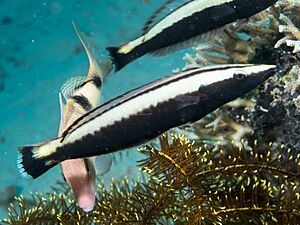Ring wrasse facts for kids
Quick facts for kids Ring wrasse |
|
|---|---|
 |
|
| adult | |
 |
|
| juveniles | |
| Conservation status | |
| Scientific classification | |
| Synonyms | |
|
The ring wrasse (scientific name: Hologymnosus annulatus), also called the ringed slender wrasse, is a beautiful fish that lives in the ocean. It belongs to the wrasse family, which is famous for its many colorful species. You can find this fish in a huge area of the world, stretching across the Indo-Pacific region.
Contents
What Does the Ring Wrasse Look Like?
The ring wrasse has two main color patterns. These patterns depend on whether the fish lives in the Indian Ocean (including the Red Sea) or the Pacific Ocean.
Adult Ring Wrasse Colors
- Female ring wrasses are usually very dark. They often look almost black.
- Male ring wrasses are mostly greenish. Their faces are a bright blue color.
- Males in the Indian Ocean often have a white band around the middle of their body.
- Pacific Ocean males show a pale area near their tail when they are ready to breed.
- Adult males also have many bluish-red stripes on their bodies.
- They might have a light yellowish stripe above their anal fin.
- Their heads are light purplish. They have green or blue-green stripes that spread out from their eyes. One stripe goes to their snout and gets wider.
Young Ring Wrasse (Juveniles)
Young ring wrasses look a lot like the young of another fish called Malacanthus latovittatus.
- They are brown to olive-brown in color.
- They have 17 to 19 dark brown stripes on their bodies.
- They have a blue and black spot on their gill cover.
- There's a black spot on the side of their lips. The spots on their lower lip are bigger.
- Their tail fin has a large, whitish crescent shape near its end.
Where Does the Ring Wrasse Live?
The ring wrasse lives in a very wide area.
- It can be found in the Red Sea.
- Its range goes south along the eastern coast of Africa to South Africa.
- It spreads east across the Indian Ocean to the Society Islands and Pitcairn Island in the Pacific.
- In the north, it reaches southern Japan.
- In the south, it goes down to the Great Barrier Reef and Rapa Island.
Habitat and Life Habits
The ring wrasse likes to live on coral reefs and in areas with rocky bottoms. You can find them in waters as deep as 30 meters (about 100 feet). They often live on the slopes of reefs that are far from shore.
Diet and Behavior
- Young ring wrasses usually live alone.
- This fish is a carnivore, which means it eats other animals.
- Its main food is small fish.
- It also eats crustaceans, like crabs or shrimp.
- Young fish tend to stay closer to the ocean floor.
- Adult fish often swim higher up in the water.
Reproduction
Ring wrasses are "pelagic spawners." This means that when they reproduce, the males and females release their eggs and sperm directly into the open water. The eggs then float and develop in the ocean currents.
Discovery of the Ring Wrasse
The ring wrasse was first officially described in the year 1801. It was given the name Labrus annulatus by a scientist named Bernard Germain de Lacépède. He wrote about it in his book called Histoire naturelle des poissons.
How People Use the Ring Wrasse
People use the ring wrasse in a couple of ways:
- It is sometimes collected for the aquarium trade. This means people buy them to keep as pets in home aquariums.
- It is also caught by small-scale fisheries. These are usually local people who catch fish for their own food or to sell in their community.


